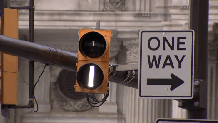What to Know
- SEPTA buses at 15th and Market streets will get a 3 second head start on other traffic.
- A special LED signal lets bus drivers know when they should start rolling.
- The measure is designed to ease traffic congestion. This intersection at Philadelphia City Hall is chronically clogged with traffic.
If you see a SEPTA bus jumping the red light at 15th and Market streets in Center City, the driver isn't breaking the law, they're just following orders.
The transit agency and the City of Philadelphia are testing a new measure that gives buses at this congested intersection a head start.
Buses get a three-second jump on the rest of the traffic. This allows the large vehicles the chance to cross lanes and merge without fighting other cars.
Market Street is five lanes wide when it hits 15th Street at Philadelphia City Hall. Traffic is forced to turn south and either continue on 15th or curve around Penn Square to hit Broad Street or continue east on Market.
A special LED signal — called a queue jump signal — lets bus drivers know when to stop and go. A horizontal white line means stop. A vertical white line means go. The signals are already used on SEPTA trolley lines.
SEPTA spokesman Andrew Busch said an end date has not been determined for the pilot program. If congestion improves, officials hope to add the signals to other busy intersections.


